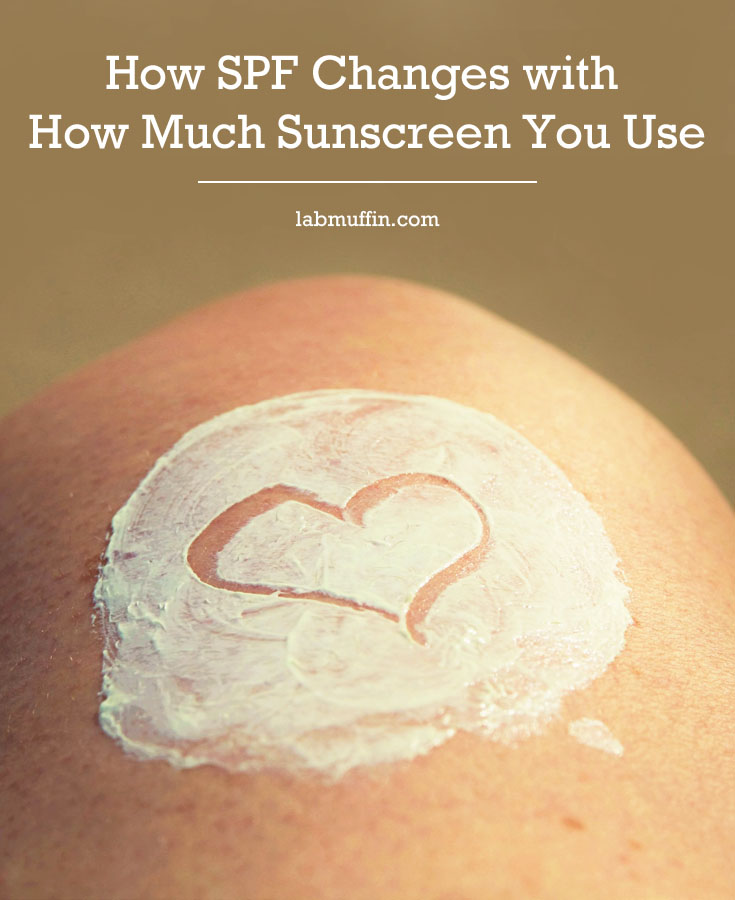
We all know that we need to apply enough sunscreen… but do any of us apply the full amount evenly, every time? Here’s what happens to your UV protection (SPF) when you apply less than the amount you should…
What Is SPF?
SPF stands for sun protection factor, and while you probably know that a larger number means more protection, most people don’t know what the number actually means.
The simple explanation of SPF is that it’s how many times more UV you can receive with the sunscreen on before you get sunburnt. For example, if your bare skin usually gets burned after 10 minutes, SPF 15 will let you stay in the sun for 150 minutes before you get burned (provided that the UV level stays constant, which probably won’t be the case in real life).
Sunscreen is tested with more sunscreen than you probably use
The amount used in the sunscreen studies to determine SPF is 2 milligrams of sunscreen per centimetre of skin (2 mg/cm²). 2 mg/cm² doesn’t sound like a lot, but it’s more than the majority of people normally use without measuring it out, even when they’re instructed to apply it liberally. It translates to 1/4 teaspoon for your face alone, and 35 mL for a full adult body, which is about half of a small tube of sunscreen (more than half a tube of Biore Watery Essence, for example). For specific areas of the body on an average adult, 2 mg/cm² means:
- 1/2 teaspoon on your face & neck combined, and each arm
- 1 teaspoon on each leg, the front of your torso and the back of your torso
using Imperial teaspoon measurements (a US teaspoon is slightly smaller). On average, people apply only a quarter to a half of the recommended amount (0.5 to 1.0 mg/cm²), and in most studies, it’s closer to 0.5 mg/cm², even with photosensitive people who are more conscious about sun damage than the average person.
What happens when you use less sunscreen (in theory)?
As you’d expect, less sunscreen means less protection. But how much less? I’ve got some good news!
In physics, you’d expect protection to decrease exponentially with less sunscreen, so applying half the amount of sunscreen would give you less than half the protection. This is based on a relationship called the Beer-Lambert law, and is illustrated on the graph below (source):
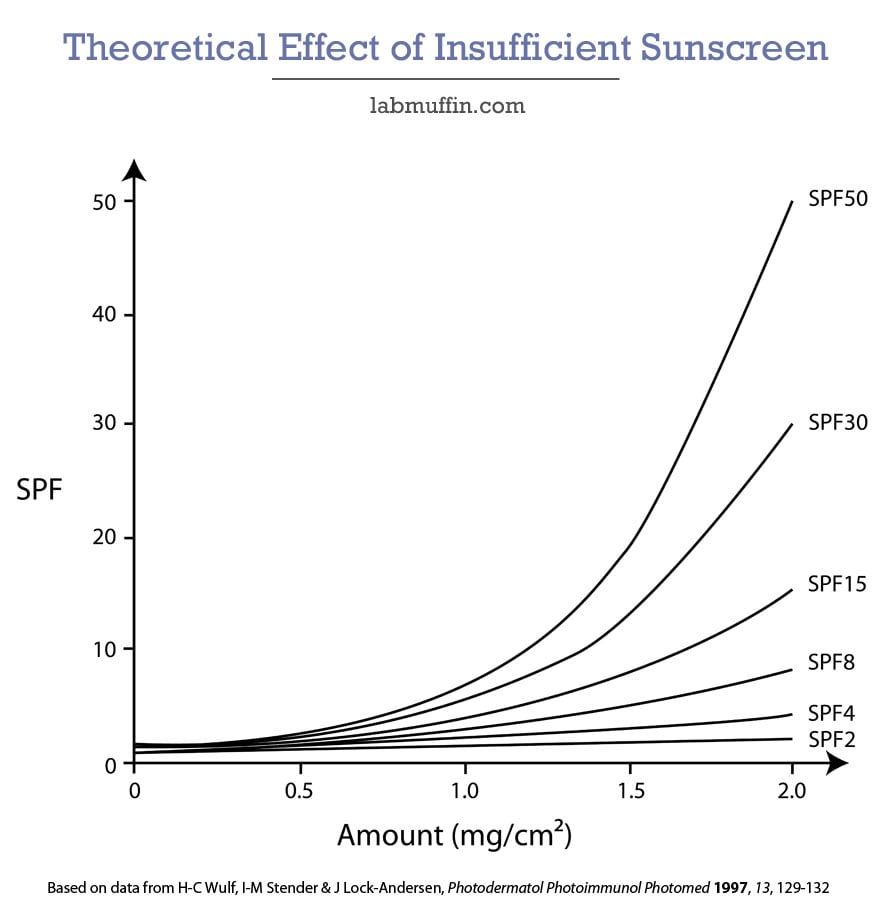
The graph shows the predicted relationship between the actual SPF and the amount of sunscreen you apply, for products with varying levels of protection (SPF 50, 30, 15, 8, 4 and 2). On the far right of the graph, you can see that 2.0 mg/cm² gives the measured protection for each product. As you’d expect, applying nothing (far left) gives negligible additional protection.
However, it’s the middle of the graph that’s disturbing. According to this theoretical relationship, reducing the applied amount by one-quarter will already halve your sun protection if you’re using SPF 30 or above. Applying half the recommended amount of sunscreen (1.0 mg/cm²) cannot give more than SPF 10, even with SPF 50 sunscreen! And as we know from earlier, most people apply less than this – we’re below SPF 3 for all products by 0.5 mg/cm².
(For those of you who are into math, the equation is SPFactual = SPF(amount applied/2).)
What actually happens when you use less sunscreen?
For years, most scientists thought using less sunscreen would decrease sun protection exponentially like in the graph above… and then some studies tested this theory out, and it seems like most sunscreens actually give a linear relationship, where half the sunscreen would actually give you around half the protection, like in the purple line below.
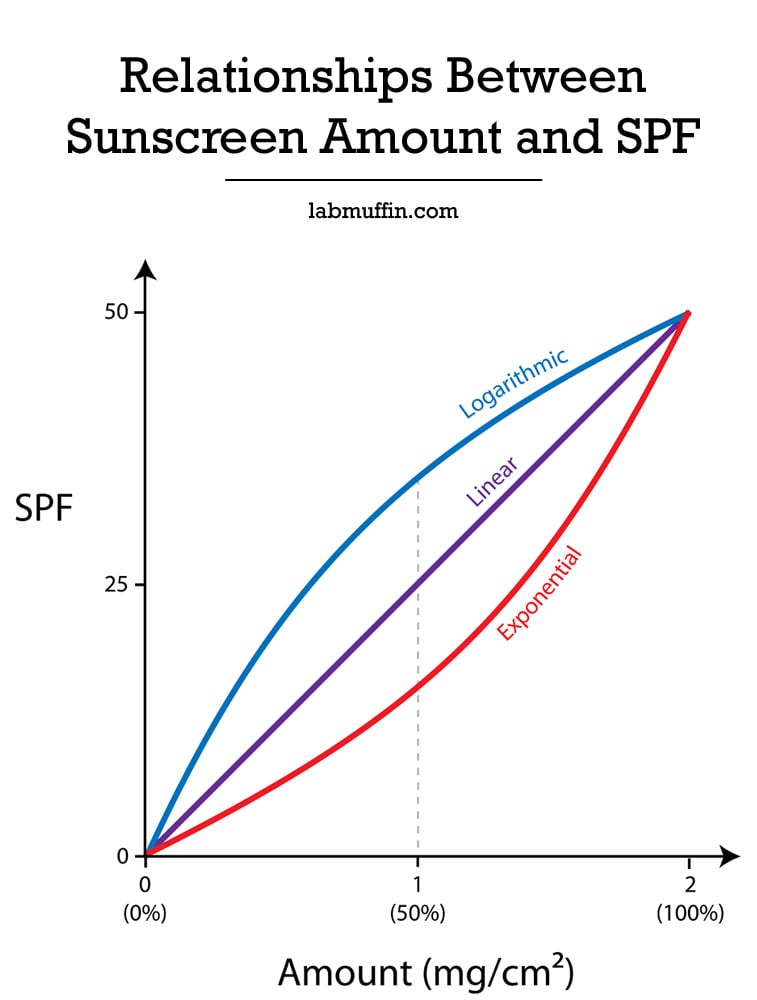
One study even found that there was a logarithmic relationship like in the blue line on the graph, where half the sunscreen would actually give you more than half of the full protection! There’s a brief summary of the relationships found in different studies in this review. In all of the studies, the protection achieved was much better than the amounts in the theoretical prediction. A good rule of thumb is that applying half of the recommended amount will give you around 1/3 to 1/2 of the labelled SPF.
The proposed reasoning for why the Beer-Lambert law fails is because it assumes an even surface, when skin is actually uneven. The reason for the different relationships found in different studies is probably because of the different products used.
Why isn’t SPF tested using realistic amounts of sunscreen?
The obvious way to rule out the confusion would be to test sunscreen using the amounts that people actually use. However, it turns out that 2 mg/cm² is needed to get reliable, reproducible results on different people, in different laboratories around the world. So while SPF isn’t very useful for working out how much longer you can stay out in the sun, it’s still useful to compare the relative protection abilities of different sunscreens.
What does this mean for my sunscreen use?
The fact that the SPF/amount relationship is closer to linear than exponential has a few interesting implications:
- Using a smaller amount of sunscreen is better than not wearing any sunscreen. While the old exponential model suggested that insufficient sunscreen wasn’t much better than no sunscreen, the actual linear relationship says otherwise. So even if you can’t manage to apply the right amount, it will still make a difference!
- Higher SPF sunscreen can be used to compensate for underapplication. A higher SPF sunscreen will always give more protection. According to the theoretical exponential relationship, the difference would be relatively small, but according to a linear relationship, the SPF will scale. This means that an SPF 30 product will always let in half as much sunburn-causing UV as an SPF 15 product. On the flip side, higher SPFs tend to result in greasier products and are more expensive which means you won’t want to apply as much, so go for the highest SPF sunscreen that you can, considering your budget and the formula.
As always, sunscreen isn’t the be-all and end-all of sun protection, or even the most important aspect. You should be avoiding sun exposure where possible, and using other types of protection as well (clothes, hats, sunglasses). You can’t underapply a shirt, and it you don’t need to remember to reapply it!
References
H Ou-Yang, J Stanfield, C Cole, Y Appa & D Rigel, High-SPF sunscreens (SPF ≥ 70) may provide ultraviolet protection above minimal recommended levels by adequately compensating for lower sunscreen user application amounts, J Am Acad Dermatol 2012, 67, 1220-1227.
B Petersen & HC Wulk, Application of sunscreen – theory and reality, Photodermatol Photoimmunol Photomed 2014, 30, 96-101.
U Osterwalder & B Herzog, The long way towards the ideal sunscreen – where we stand and what still needs to be done, Photochem Photobiol Sci 2010, 9, 470-481.
[lastupdate]


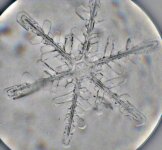
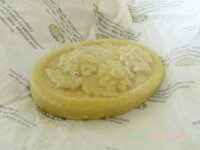

Hi Michelle, thank you for the explanation on sunscreens, I find it very useful, like the rest of your blog:) It’s one of a very few places on the web where I know I can trust the information I read.
I’ve got a question about “chemical” sunscreens – is it true that they desintegrate under direct sunlight? Say, if one applies the right amount and go into sunshine (no swimming to make the case simpler), how long does it take for the protection to expire?
And another question, if I apply “chemical” sunscreen, and then stay indoors for a few hours (again, no washing or rubbing off), and then go outside (like on a lunchbreak;) does it mean that the applied sunscreen is still 100% working, nothing desintegrated?
Yep, some chemical (organic) sunscreens aren’t photostable – avobenzone in particular is pretty notorious for degrading in the sun! Applying every 2 hours will get around this. Avobenzone can also be combined with other filters to improve photostability, but the list is quite big – I’d ask the company or look on their website to check if it’s photostable. Other organic sunscreens generally don’t have this problem.
Not necessarily – sunscreen needs reapplying for a few different reasons: photodegradation, smearing it off, and the sunscreen layer becoming uneven over time (even without you touching it, like how a foundation clumps over time when your skin releases sweat and sebum). The final reason will mean it won’t be 100%, even if you don’t touch it at all. How much the layer changes over time depends on the sunscreen formula and there isn’t an easy way to work it out, but generally water-resistant sunscreens will stay OK for longer.
As always, thank you for putting together this super informative and well organized post! This answers so many questions I’ve had about sunscreen for so long.
Thank you! 🙂
Amazing post! Super in depth, I really enjoyed it. Especially enjoyed all the journal/study references!
Thanks! I try to include as many open access articles as I can so people can read more if they’re interested, but there weren’t many open access articles this time around unfortunately! Although there are sneaky ways of getting things…
I’ve always wondered about the differences between different SPF’s but never bothered to google it myself. Had to give this a read this time for a good reason. That is a whole lot of information on sunscreen a few days before a trip to the islands. I am thankful, indeed.
I’m glad I helped! 🙂
Such good points made here. I think I’m going to go out and buy a hat now.
Hats are great! Especially for scalp protection 🙂
I use enough but I’m the only sun conscious person I know and I always get told I’m using too much when I’m not. Does that amount apply to moisturizer too or do I have to apply more moisturizer than I would straight sunscreen?
And I probably get burnt after 1 minute in the sun without sunscreen ??
It’s the same amount for moisturiser as sunscreen – I have a post on it actually! Does a moisturiser with SPF protect as well as a sunscreen?
The main differences are broad spectrum and water resistance, but the amount you need doesn’t change 🙂
That makes me feel better. I use way more than 1/4 tsp on my face of physical sunscreen in spf 45. It takes a while to rub the white color away though. I’ve found no matter how much I use, chemical sunscreens like the one from Paula’s Choice in the orange tube just don’t do the job. I always start to burn in a couple of hours, even if I put it on heavily and reapply like I should. And I don’t live on the equator or anything (I’m at the 42nd parallel)
American chemical sunscreens suck for the most part. I’m very sun sensitive and the only chemical sunscreens I don’t burn with are the ones with more advanced chemical sunscreens like the tinosorbs or mexoryl. I agree physical sunscreens are superior if you add enough but not everyone can use them due to their overwhelming white cast.
I agree, American sunscreens are pretty rubbish! I wish the US would update their regulations…
I mostly use combination sunscreens – physical alone doesn’t have the UVA protection I want (Fitzpatrick III means I’m super prone to sunspots), and that white cast problem…
I highly recommend covering up with hats and clothing!
Great article! I probably do use at least half a teaspoon on my neck and face (maybe more) but I’m way stingy on my body. Will keep this in mine next beach day!
Thank you! Me too, body sunscreen takes so long to apply…
Thanks for getting into the nuts and bolts! I always go for a 50/+++(+) and try to apply 1/4 teaspoon, but that much spf under makeup can go very, very awry. If you apply 1/8 tsp of sunscreen and then apply makeup with a 50 spf over it, would that bump up the spf closer to the labeled spf?
It will! But it’s still proportional to how much product you use, and with most people and most makeup products, the amount of protection that makeup will add will be very small.
Would you also suggest wearing sunscreen indoors, since UVA rays pass through glass?
Thanks,
Madalina.
I really want to know this too
I don’t think it’s necessarily unless you sit next to a window that receives a fair bit of light! From the truck driver photo, his good side received a lot of indirect sunlight, and it was far, far better than the bad, direct sunlight half.
I don’t think it’s necessarily unless you sit next to a window that receives a fair bit of light! From the truck driver photo, his good side received a lot of indirect sunlight, and it was far, far better than the bad, direct sunlight half.
When I went tubing on the river this summer with a bunch of boys I covered myself with SPF 30+ all over before I even left the house – SPF 70 for face and chest where I always burn first. I don’t know how much I used, but I definitely wasn’t stingy knowing I’d be in the sun on the water for hours.
All the boys put on SPF 30 sunspray before we left. Same brand as my lotion, but they used spray. We all reapplied half way through the trip.
I wasn’t burned at all. The next day at work I learned all of the boys were badly burned all over. However convenient the sprays are – it seems they tempt you to under apply even more than you would with lotion. 🙂
Yeah, I find the sprays pretty misleading – you have to rub them in to apply them evenly, but rubbing also decreases their effectiveness, and it’s not that much harder to squeeze out a glob of sunscreen!
This is such an awesome and helpful article, thank you sooo much!
I have a question. Are those theories (or generally all theories/information) about SPF also one-on-one applicable to the PPD (or other measuring methods for UVA-protection)
For example there is this chart that explains against how many % of UVB rays the SPF protects, e.g. an SPF of 10 will protect against 90% of UVB rays, an SPF of 50 against 98% etc. But is this correlation between SPF and UVB protection also true/applicable for the correlation between PPD and UVA protection? As in, will a PPD of 10 protect against 90% of the UVA rays and a PPD of 50 against 98% of the UVA rays?
I’m wondering about this in particular because my current sunscreen has a PPD of 42, but I’ve found one that I like a little more, but it only has a PPD of 33, and now I’m unsure if I should still switch to the one I like more. I was thinking that if that correlation from the chart in regards to SPF and UVB also works for PPD and UVA, then I’ll probably switch because according to the chart, an SPF of 30 protects against 97% of UVB rays and an SPF of 50 only against 98%, so the difference I think between 33 and 42 (in regards to the PPD) would be really small. But I don’t know if I can just use that info about the SPF and apply it to the PPD. Do you know that?
I’m sorry for writing so much! I hope my problem makes sense. Thank you so much for this article again!
Yes you’re right, it applies to UVA and PPD/PA as well 🙂
Thank you so much!
That’s really good to know, because I’ve always had the impression that you find quite a lot of info on SPF, but not so much on PPD (or other UVA-measurements), which left me a little unsure, but given that they do correlate that actually makes sense.
In the article you mention that a higher SPF can be used to compensate for underapplication. Do you think it’s still okay to switch to a sunscreen with a lower PPD (going from a PPD of 42 to one of 33) if the latter absorbs more easily/makes it easier to apply a bigger amount and is easier to reapply?
And, I don’t know if you’ve mentioned this in another article (if so, I’m sorry), but can I ask how much sunscreen exactly you use on your face? I feel so unsure about that aspect. :/
Thank you again so much!
Oh I’m sorry, I’m adding another comment because I forgot to enable the email notification with my first one, sorry!
Replied! 🙂
Brilliant article and blog!
-Pharmacist, Vancouver, Canada
People remember this. Sun is also good for your skin, in moderation of course.
Dear Michelle, I appreciate your knowledge and the information you provide. I have a hypothetical question: assuming you use a sufficient amount of sunsceen A (SPF 50 sunscreen) – let it fully dry on your skin and layer a (also sufficient) amount of sunscreen B (30 SPF sunsceen) on top of the 50 SPF sunscreen. Assuming the filters of the both sunscreens are not going to degrade each other, which resulting SPF will you achieve and why? Thank you very much for your answer in advance. Greetings from Germany, Lina
It’s impossible to say unfortunately – there are so many factors that go into determining the SPF!
Hey Michelle- i love your work. Thanks for this incredibly informative blog post 🙂 i have a related question that i was hoping you could help me with: did I understand correctly that it’s the consensus that in vivo trials proved that the relationship between the thickness of sunscreen application and the spf/ppd is linear? And that the previous in vitro trials had (erroneously) assumed they would be exponential? I ask because from what I’m seeing online it looks like theres no consensus, ie that some in vivo studies show that in higher spfs its actually exponential. But im really hoping that im just missing something/didn’t understand correctly. Thanks again for all your hard work! Will hope to hear your thoughts on this 🙂 🤞🏻
Hello!
Great blog you have going on 🙂 Very informative!
I was wondering do you have a page where you talk about sunscreens that you do like?
There are some here: https://labmuffin.com/my-sunscreen-mini-review-spreadsheet/ and here: https://labmuffin.com/video-my-top-6-favourite-sunscreens/
Hi Michelle! I have a question about reapplication. Most days I am indoors, except to walk my dog twice a day or driving to the store. I was wondering if using a full 1/4 tsp for my face and neck would provide me an even layer of protection for the day so I won’t need to reapply. My apartment does get very sunny in the afternoon with lots of direct and indirect light. I’m also using Elta MD’s Physical Tinted SPF 41.
Unfortunately reapplication isn’t about quantity, but time – the sunscreen film breaks up as time goes on, so it stops giving as good protection as it should.
Okay thank you!